Auto Purge (Virus Removal Instructions) - Chrome, Firefox, IE, Edge
Auto Purge Removal Guide
What is Auto Purge?
Auto Purge extension for Chrome may expose users to potentially dangerous third-party sites
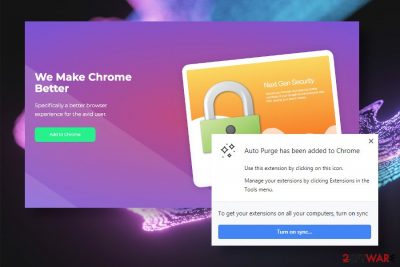
Auto Purge extension for Chrome is a tricky third-party tool that promises potential users many useful features, while in reality, it can hardly fulfill any of them. Prevent tracking of search history, stop advertisements from chasing you, and cleaning Chrome's history automatically are the three things that this tool promises to do. However, do not fall for believing it blindly because this extension has recently been classified as a browser hijacker and potentially unwanted application (PUA) due to intolerable activities.
Based on the NoVirus.uk[1] researchers, Auto Purge has been spreading in disguise with freeware as a pre-selected component (hidden under Quick installation setup). Consequently, it reached thousands of computers without users' authorization. Its primary goal – to set sponsored Bing search instead of a default search engine, replace start page, new tab window, and other Chrome settings to make people see the content of its sponsors and take control over users' web traffic.
Thus, even though this dubious extension promises its users to disable ads and improve their online privacy, it disables original ads and replaces them with the content of its sponsors, promotes questionable third-party websites, and injects its own cookies to monitor users' web browsing activities. Therefore, it's advisable to remove Auto Purge extension from Chrome without a delay.
| Name | Auto Purge |
| Developer | Responsible LLC, registered by GoDaddy.com LLC |
| Classification | Browser hijacker, Potentially Unwanted Program (PUP) |
| Compatibility | The extension has been developed for Chrome. Can settle down on Windows and Macs |
| Distribution | Direct download from the official website. Direct download from Chrome Web Store. Indirect download via freeware bundles |
| Symptoms | If the user downloads the extension, all he or she notices – abnormal web browser's behavior: – search.bing.com is set instead of a default search engine; – start page and new tab windows altered without permission; – web browser regularly reroutes to suspicious third-party websites; – intrusive ads and pop-ups cover the original content on most of the visited websites; – tracking cookies are installed for ongoing monitoring of browsing activities; |
| Danger level | Relatively low. The extension is not capable of causing direct harm to the system. The only risk that it causes – exposure to dangerous malware-infected sites |
| Removal options | Browser hijackers target to attack web browsers. Thus, it's a must to restore the web browser's settings in the first place. After that, eliminate PUPs from the machine. Manual removal is possible, however, you can kill two birds with one stone by running a scan with a robust anti-malware tool |
| Recovery | Each unwanted application leaves its footprint on the system. Thus, experts recommend taking care of the system and regularly optimize it with FortectIntego software. |
The Auto Purge extension for Chrome promises to disable third-party content, including intrusive advertising and cookies that disrupt web browsing activities and interfere the privacy. The problem is that the extension is sponsored by third parties, meaning that it is programmed to show the content of its sponsored for an agreed commission fee. Here's an excerpt from the EULA[2] of the extension:
The Services may contain links to other Internet websites and services owned by third parties. Your use of each of those websites and services is subject to the conditions, if any, that each of those websites has posted. You acknowledge and agree that we have no control over websites that are not ours, and we are not responsible for any changes to and/or content on them. Our inclusion of any third-party Content or a link to a third-party website or service is not an endorsement of such third-party content or third-party site. […] Any questions, complaints, or claims related to any product or service should be directed to the appropriate third party.
The Auto Purge redirects should not be tolerated because no one knows what parties initiate them and what content is positioned behind. In the worst-case scenario, you may get exposed to phishing sites where you may be offered to participate in prize giveaways in exchange for your personal details (first name, last name, telephone number, e-mail address, home address, etc.). In addition to that, you can also be tricked into visiting malware-infected websites that spread malware like Auto Refresh, Dirty Tinder, CookieMiner, and others.
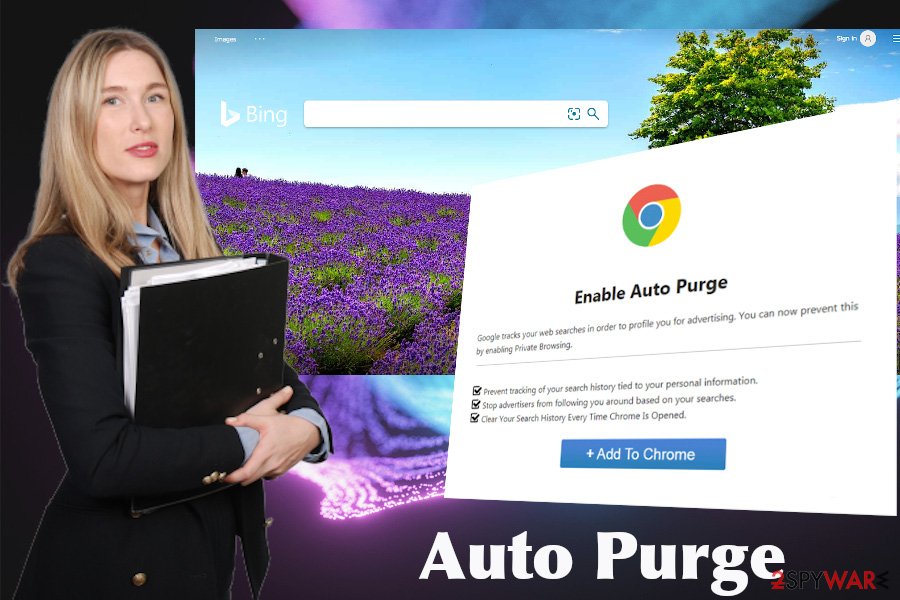
Apart from rather aggressive advertising, Auto Purge removal is recommended to improve privacy security. The extension is represented as a tool that protects privacy. On the one hand, it blocks third-party cookies. On the other hand, it enables its own cookies and web beacons to record personally non-identifiable information (PII) and then shares it with the sponsors for marketing improvements.
- User IP Address;
- Search Term;
- Ad clicked, Organic/Web results clicked & Search Engine Overridden;
- User-Agent.
Therefore, we strongly recommend you to remove Auto Purge virus from your machine. It does not have a real value, except ambiguous activities. Luckily, it's removal is not too difficult – a manageable task for less experienced PC users. You can select either manual or automatic removal option.
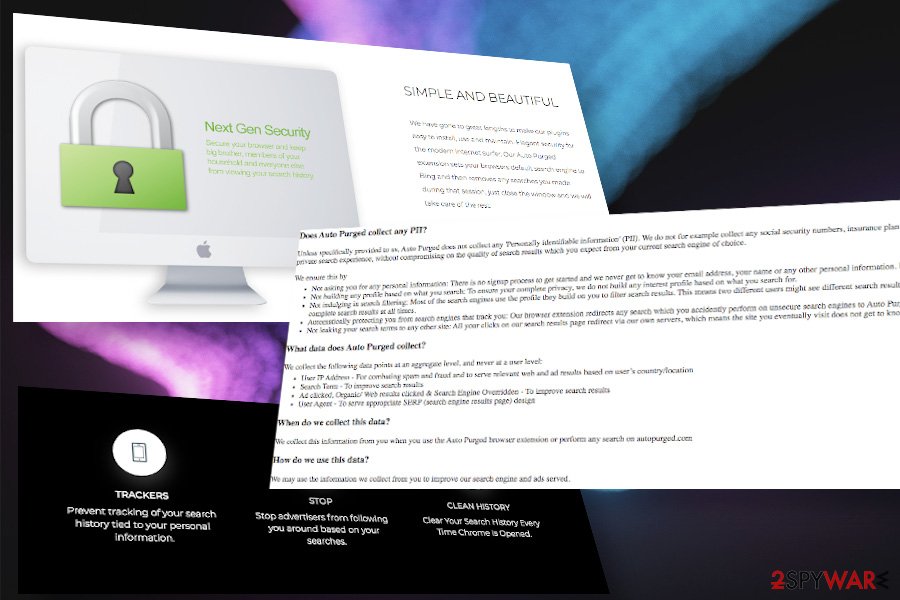
Manual Auto Purge removal should be initiated in stages, i.e. PUP removal, extension removal, and full system optimization. Users can find manual elimination guidance and recommended anti-malware tools at the end of this article. Additionally, we recommend not leaving the system caches with outdated registry entries. This task can be initiated by FortectIntego optimizer.
Make a research on any freeware before installing it
This Chrome extension has the official download website where it is promoted in a rather appealing manner. The download costs nothing and, we believe, that people who accidentally land on this site may decide to tithe this browser-based a try. However, direct downloads are very rare.
Usually, PUPs like this are downloaded in bundled[3], which is why users often don't even realize that they have installed unwanted applications. The so-called “bundling” is a method known for ages, though for the last ten years it has been misused for distributing PUPs and other malware.
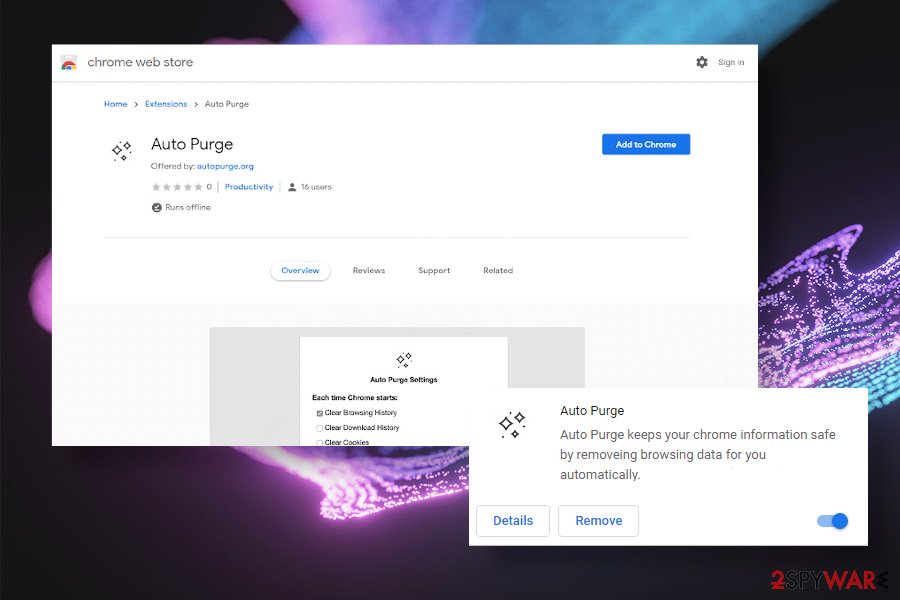
That's why it's so important to download freeware purposely and deliberately. Choose official websites if possible, download freeware by picking up the Advanced/Custom installation technique, reject the installation of additional components (add-ons, toolbars, plug-ins, etc.).
Ways of getting rid of Auto Purge malware
Remember that Auto Purge virus is capable of displaying third-party content, initiated ongoing web browser's redirects, and collecting browsing-related information behind your back. Even though it cannot be called a virus, the content it returns can be misleading or even dangerous.
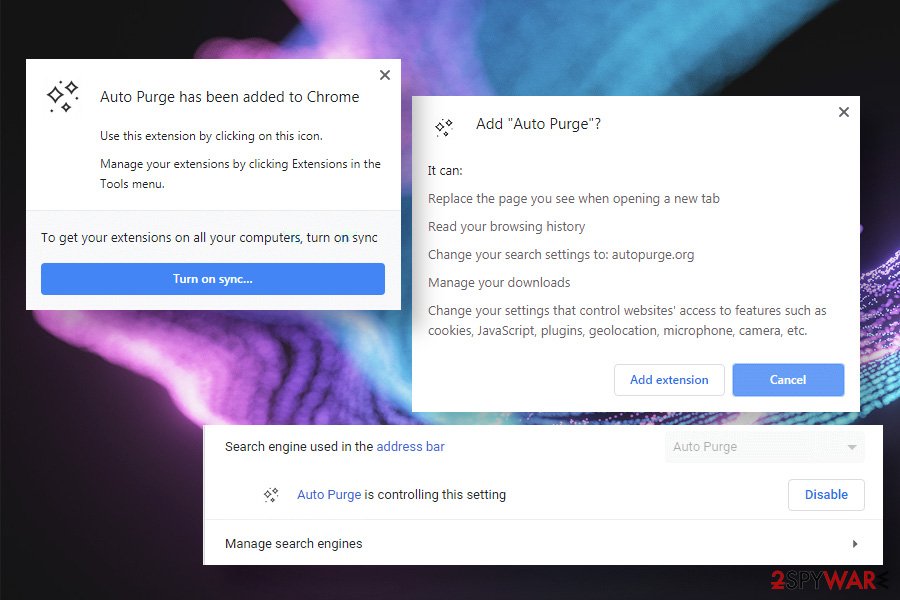
Therefore, we recommend people to initiate a full Auto Purge removal as soon as it starts showing signs of presence. The easiest way to do that is to run a full scan with a robust anti-malware tool. Nevertheless, the web browser's settings will have to be restored manually.
When you remove Auto Purge-related malware from the system, you should open the web browser and delete the extension manually. First of all, disable the extension and then delete the search engine. At best, restore the default Chrome's settings.
You may remove virus damage with a help of FortectIntego. SpyHunter 5Combo Cleaner and Malwarebytes are recommended to detect potentially unwanted programs and viruses with all their files and registry entries that are related to them.
Getting rid of Auto Purge. Follow these steps
Uninstall from Windows
The following list explains how to eliminate PUPs from Windows.
Instructions for Windows 10/8 machines:
- Enter Control Panel into Windows search box and hit Enter or click on the search result.
- Under Programs, select Uninstall a program.

- From the list, find the entry of the suspicious program.
- Right-click on the application and select Uninstall.
- If User Account Control shows up, click Yes.
- Wait till uninstallation process is complete and click OK.

If you are Windows 7/XP user, proceed with the following instructions:
- Click on Windows Start > Control Panel located on the right pane (if you are Windows XP user, click on Add/Remove Programs).
- In Control Panel, select Programs > Uninstall a program.

- Pick the unwanted application by clicking on it once.
- At the top, click Uninstall/Change.
- In the confirmation prompt, pick Yes.
- Click OK once the removal process is finished.
Delete from macOS
Mac users can also get infected by Auto Purge. In this case, follow this tutorial to remove it.
Remove items from Applications folder:
- From the menu bar, select Go > Applications.
- In the Applications folder, look for all related entries.
- Click on the app and drag it to Trash (or right-click and pick Move to Trash)

To fully remove an unwanted app, you need to access Application Support, LaunchAgents, and LaunchDaemons folders and delete relevant files:
- Select Go > Go to Folder.
- Enter /Library/Application Support and click Go or press Enter.
- In the Application Support folder, look for any dubious entries and then delete them.
- Now enter /Library/LaunchAgents and /Library/LaunchDaemons folders the same way and terminate all the related .plist files.

Remove from Microsoft Edge
Delete unwanted extensions from MS Edge:
- Select Menu (three horizontal dots at the top-right of the browser window) and pick Extensions.
- From the list, pick the extension and click on the Gear icon.
- Click on Uninstall at the bottom.

Clear cookies and other browser data:
- Click on the Menu (three horizontal dots at the top-right of the browser window) and select Privacy & security.
- Under Clear browsing data, pick Choose what to clear.
- Select everything (apart from passwords, although you might want to include Media licenses as well, if applicable) and click on Clear.

Restore new tab and homepage settings:
- Click the menu icon and choose Settings.
- Then find On startup section.
- Click Disable if you found any suspicious domain.
Reset MS Edge if the above steps did not work:
- Press on Ctrl + Shift + Esc to open Task Manager.
- Click on More details arrow at the bottom of the window.
- Select Details tab.
- Now scroll down and locate every entry with Microsoft Edge name in it. Right-click on each of them and select End Task to stop MS Edge from running.

If this solution failed to help you, you need to use an advanced Edge reset method. Note that you need to backup your data before proceeding.
- Find the following folder on your computer: C:\\Users\\%username%\\AppData\\Local\\Packages\\Microsoft.MicrosoftEdge_8wekyb3d8bbwe.
- Press Ctrl + A on your keyboard to select all folders.
- Right-click on them and pick Delete

- Now right-click on the Start button and pick Windows PowerShell (Admin).
- When the new window opens, copy and paste the following command, and then press Enter:
Get-AppXPackage -AllUsers -Name Microsoft.MicrosoftEdge | Foreach {Add-AppxPackage -DisableDevelopmentMode -Register “$($_.InstallLocation)\\AppXManifest.xml” -Verbose

Instructions for Chromium-based Edge
Delete extensions from MS Edge (Chromium):
- Open Edge and click select Settings > Extensions.
- Delete unwanted extensions by clicking Remove.

Clear cache and site data:
- Click on Menu and go to Settings.
- Select Privacy, search and services.
- Under Clear browsing data, pick Choose what to clear.
- Under Time range, pick All time.
- Select Clear now.

Reset Chromium-based MS Edge:
- Click on Menu and select Settings.
- On the left side, pick Reset settings.
- Select Restore settings to their default values.
- Confirm with Reset.

Remove from Mozilla Firefox (FF)
Remove dangerous extensions:
- Open Mozilla Firefox browser and click on the Menu (three horizontal lines at the top-right of the window).
- Select Add-ons.
- In here, select unwanted plugin and click Remove.

Reset the homepage:
- Click three horizontal lines at the top right corner to open the menu.
- Choose Options.
- Under Home options, enter your preferred site that will open every time you newly open the Mozilla Firefox.
Clear cookies and site data:
- Click Menu and pick Settings.
- Go to Privacy & Security section.
- Scroll down to locate Cookies and Site Data.
- Click on Clear Data…
- Select Cookies and Site Data, as well as Cached Web Content and press Clear.

Reset Mozilla Firefox
If clearing the browser as explained above did not help, reset Mozilla Firefox:
- Open Mozilla Firefox browser and click the Menu.
- Go to Help and then choose Troubleshooting Information.

- Under Give Firefox a tune up section, click on Refresh Firefox…
- Once the pop-up shows up, confirm the action by pressing on Refresh Firefox.

Remove from Google Chrome
Auto Purge extension is compatible with the Google Chrome browser only. To disable it, follow these steps:
Delete malicious extensions from Google Chrome:
- Open Google Chrome, click on the Menu (three vertical dots at the top-right corner) and select More tools > Extensions.
- In the newly opened window, you will see all the installed extensions. Uninstall all the suspicious plugins that might be related to the unwanted program by clicking Remove.

Clear cache and web data from Chrome:
- Click on Menu and pick Settings.
- Under Privacy and security, select Clear browsing data.
- Select Browsing history, Cookies and other site data, as well as Cached images and files.
- Click Clear data.

Change your homepage:
- Click menu and choose Settings.
- Look for a suspicious site in the On startup section.
- Click on Open a specific or set of pages and click on three dots to find the Remove option.
Reset Google Chrome:
If the previous methods did not help you, reset Google Chrome to eliminate all the unwanted components:
- Click on Menu and select Settings.
- In the Settings, scroll down and click Advanced.
- Scroll down and locate Reset and clean up section.
- Now click Restore settings to their original defaults.
- Confirm with Reset settings.

Delete from Safari
Remove unwanted extensions from Safari:
- Click Safari > Preferences…
- In the new window, pick Extensions.
- Select the unwanted extension and select Uninstall.

Clear cookies and other website data from Safari:
- Click Safari > Clear History…
- From the drop-down menu under Clear, pick all history.
- Confirm with Clear History.

Reset Safari if the above-mentioned steps did not help you:
- Click Safari > Preferences…
- Go to Advanced tab.
- Tick the Show Develop menu in menu bar.
- From the menu bar, click Develop, and then select Empty Caches.

After uninstalling this potentially unwanted program (PUP) and fixing each of your web browsers, we recommend you to scan your PC system with a reputable anti-spyware. This will help you to get rid of Auto Purge registry traces and will also identify related parasites or possible malware infections on your computer. For that you can use our top-rated malware remover: FortectIntego, SpyHunter 5Combo Cleaner or Malwarebytes.
How to prevent from getting browser hijacker
Access your website securely from any location
When you work on the domain, site, blog, or different project that requires constant management, content creation, or coding, you may need to connect to the server and content management service more often. The best solution for creating a tighter network could be a dedicated/fixed IP address.
If you make your IP address static and set to your device, you can connect to the CMS from any location and do not create any additional issues for the server or network manager that needs to monitor connections and activities. VPN software providers like Private Internet Access can help you with such settings and offer the option to control the online reputation and manage projects easily from any part of the world.
Recover files after data-affecting malware attacks
While much of the data can be accidentally deleted due to various reasons, malware is one of the main culprits that can cause loss of pictures, documents, videos, and other important files. More serious malware infections lead to significant data loss when your documents, system files, and images get encrypted. In particular, ransomware is is a type of malware that focuses on such functions, so your files become useless without an ability to access them.
Even though there is little to no possibility to recover after file-locking threats, some applications have features for data recovery in the system. In some cases, Data Recovery Pro can also help to recover at least some portion of your data after data-locking virus infection or general cyber infection.
- ^ Security and spyware news. NoVirus. Virus and spyware news.
- ^ Terms of Service. Autopure. Official website, terms of service.
- ^ Liam Tung. Google: Unwanted bundled software is way more aggressive than malware. ZDnet. Business technology news.























